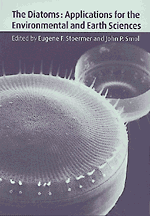Book contents
- Frontmatter
- Contents
- Contributors
- Preface
- Part I Introduction
- Part II Diatoms as indicators of environmental change in flowing waters and lakes
- Part III Diatoms as indicators in extreme environments
- Part IV Diatoms as indicators in marine and estuarine environments
- 13 Diatoms as indicators of coastal paleoenvironments and relative sea-level change
- 14 Diatoms and environmental change in brackish waters
- 15 Applied diatom studies in estuaries and shallow coastal environments
- 16 Estuarine paleoenvironmental reconstructions using diatoms
- 17 Diatoms and marine paleoceanography
- Part V Other applications
- Part VI Conclusions
- Glossary, and acronyms
- Index
13 - Diatoms as indicators of coastal paleoenvironments and relative sea-level change
Published online by Cambridge University Press: 16 January 2010
- Frontmatter
- Contents
- Contributors
- Preface
- Part I Introduction
- Part II Diatoms as indicators of environmental change in flowing waters and lakes
- Part III Diatoms as indicators in extreme environments
- Part IV Diatoms as indicators in marine and estuarine environments
- 13 Diatoms as indicators of coastal paleoenvironments and relative sea-level change
- 14 Diatoms and environmental change in brackish waters
- 15 Applied diatom studies in estuaries and shallow coastal environments
- 16 Estuarine paleoenvironmental reconstructions using diatoms
- 17 Diatoms and marine paleoceanography
- Part V Other applications
- Part VI Conclusions
- Glossary, and acronyms
- Index
Summary
Introduction
Since nineteenth century naturalists identified salinity as a major determinant of diatom distribution, the remains of these organisms have become popular paleoenvironmental indicators for coastal deposits. A variety of problems in coastal geology were tackled using diatom-based methods, covering fields such as stratigraphy, the study of coastal processes, paleogeography, sea-level and climate change, tectonics, natural hazard assessment and archeology. This review highlights some of the major prospects and problems of paleoenvironmental diatom research on former depositional environments and sedimentation conditions in the coastal zone, as well as its contribution to the study of relative sea-level change and other processes affecting coastal genesis. For several reasons, e.g., the early recognition of important sea-level variations and coastline changes relating to glacial/interglacial cycles, the projected impact of possible future sea-level rise on coastal lowlands, the comparability of the fossil biotic record to contemporaneous observations, and the development of high-resolution dating methods – such research has focused mainly on the Quaternary and the Holocene in particular. Relatively few studies reached further back in time (e.g., Burckle & Akiba, 1978; Harwood, 1986; Pickard et al., 1986; Tawfik & Krebs, 1995). This account therefore also deals primarily with the most recent geological time window, where techniques and applications are most refined. Intended as a brief introduction only, completeness is not attempted. Some closely related topics, such as the ecology of marine–littoral diatoms, salinity calibration, estuarine settings and archeological contexts are treated more in detail elsewhere in this volume.
- Type
- Chapter
- Information
- The DiatomsApplications for the Environmental and Earth Sciences, pp. 277 - 297Publisher: Cambridge University PressPrint publication year: 1999
- 19
- Cited by



